Community Health and Disease Prevention Report - Dengue Analysis
VerifiedAdded on 2022/08/18
|9
|2556
|10
Report
AI Summary
This report examines community health strategies for dengue prevention, emphasizing the vital role of community participation in raising awareness and managing the disease. It highlights the importance of integrated management, including vector control, data improvement, enhanced diagnosis, and surveillance. The report discusses Laverack's ladder of participation, leadership building, and policy-making as key strategies. It also addresses the development of core domains for capacity building, focusing on communication strategies and the use of digital media to disseminate information. The report emphasizes the importance of credible sources, knowledge utilization, and the need for effective community engagement to manage the disease and prevent its spread, ultimately aiming to reduce the impact of dengue through awareness and preventive measures.
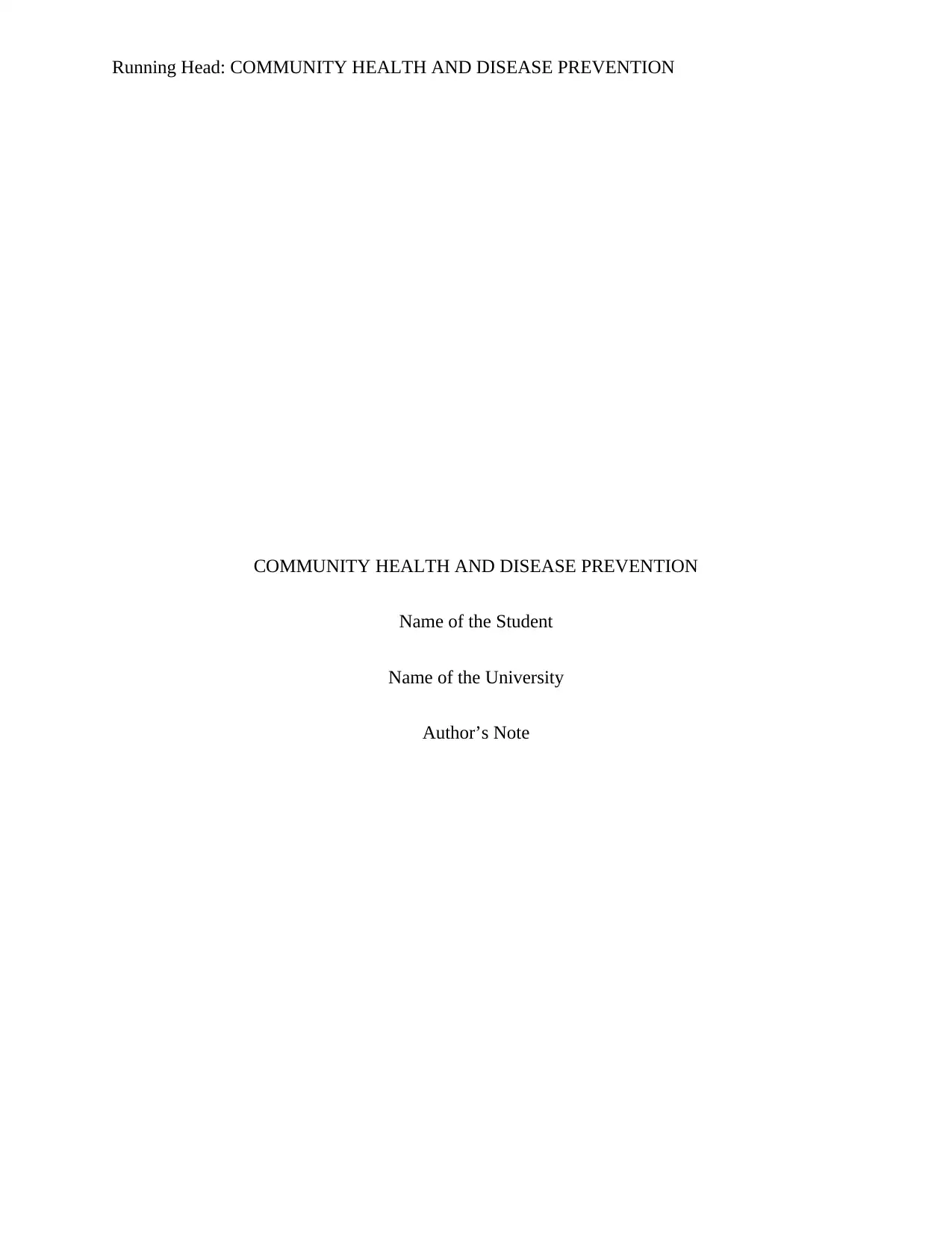
Running Head: COMMUNITY HEALTH AND DISEASE PREVENTION
COMMUNITY HEALTH AND DISEASE PREVENTION
Name of the Student
Name of the University
Author’s Note
COMMUNITY HEALTH AND DISEASE PREVENTION
Name of the Student
Name of the University
Author’s Note
Paraphrase This Document
Need a fresh take? Get an instant paraphrase of this document with our AI Paraphraser
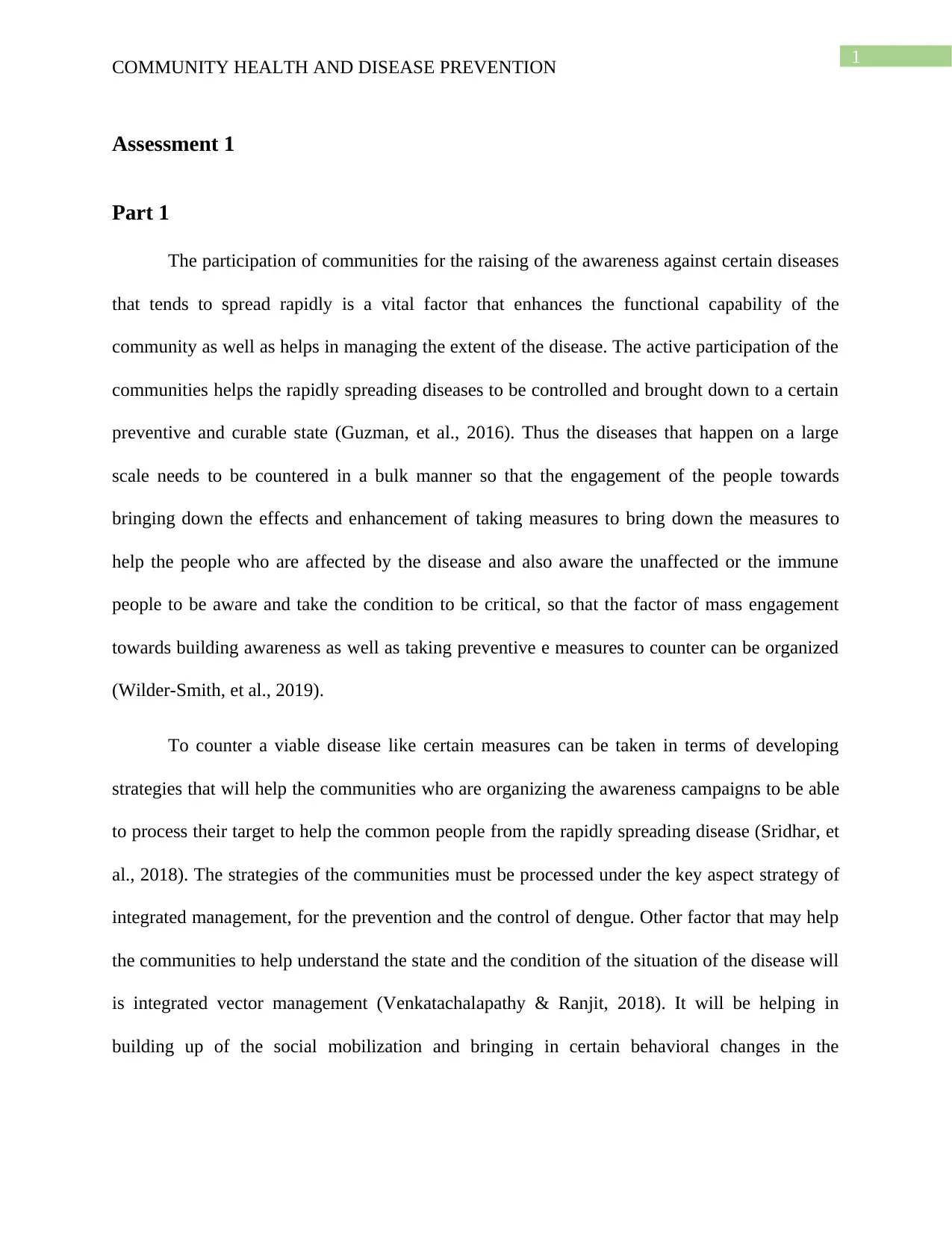
1
COMMUNITY HEALTH AND DISEASE PREVENTION
Assessment 1
Part 1
The participation of communities for the raising of the awareness against certain diseases
that tends to spread rapidly is a vital factor that enhances the functional capability of the
community as well as helps in managing the extent of the disease. The active participation of the
communities helps the rapidly spreading diseases to be controlled and brought down to a certain
preventive and curable state (Guzman, et al., 2016). Thus the diseases that happen on a large
scale needs to be countered in a bulk manner so that the engagement of the people towards
bringing down the effects and enhancement of taking measures to bring down the measures to
help the people who are affected by the disease and also aware the unaffected or the immune
people to be aware and take the condition to be critical, so that the factor of mass engagement
towards building awareness as well as taking preventive e measures to counter can be organized
(Wilder-Smith, et al., 2019).
To counter a viable disease like certain measures can be taken in terms of developing
strategies that will help the communities who are organizing the awareness campaigns to be able
to process their target to help the common people from the rapidly spreading disease (Sridhar, et
al., 2018). The strategies of the communities must be processed under the key aspect strategy of
integrated management, for the prevention and the control of dengue. Other factor that may help
the communities to help understand the state and the condition of the situation of the disease will
is integrated vector management (Venkatachalapathy & Ranjit, 2018). It will be helping in
building up of the social mobilization and bringing in certain behavioral changes in the
COMMUNITY HEALTH AND DISEASE PREVENTION
Assessment 1
Part 1
The participation of communities for the raising of the awareness against certain diseases
that tends to spread rapidly is a vital factor that enhances the functional capability of the
community as well as helps in managing the extent of the disease. The active participation of the
communities helps the rapidly spreading diseases to be controlled and brought down to a certain
preventive and curable state (Guzman, et al., 2016). Thus the diseases that happen on a large
scale needs to be countered in a bulk manner so that the engagement of the people towards
bringing down the effects and enhancement of taking measures to bring down the measures to
help the people who are affected by the disease and also aware the unaffected or the immune
people to be aware and take the condition to be critical, so that the factor of mass engagement
towards building awareness as well as taking preventive e measures to counter can be organized
(Wilder-Smith, et al., 2019).
To counter a viable disease like certain measures can be taken in terms of developing
strategies that will help the communities who are organizing the awareness campaigns to be able
to process their target to help the common people from the rapidly spreading disease (Sridhar, et
al., 2018). The strategies of the communities must be processed under the key aspect strategy of
integrated management, for the prevention and the control of dengue. Other factor that may help
the communities to help understand the state and the condition of the situation of the disease will
is integrated vector management (Venkatachalapathy & Ranjit, 2018). It will be helping in
building up of the social mobilization and bringing in certain behavioral changes in the
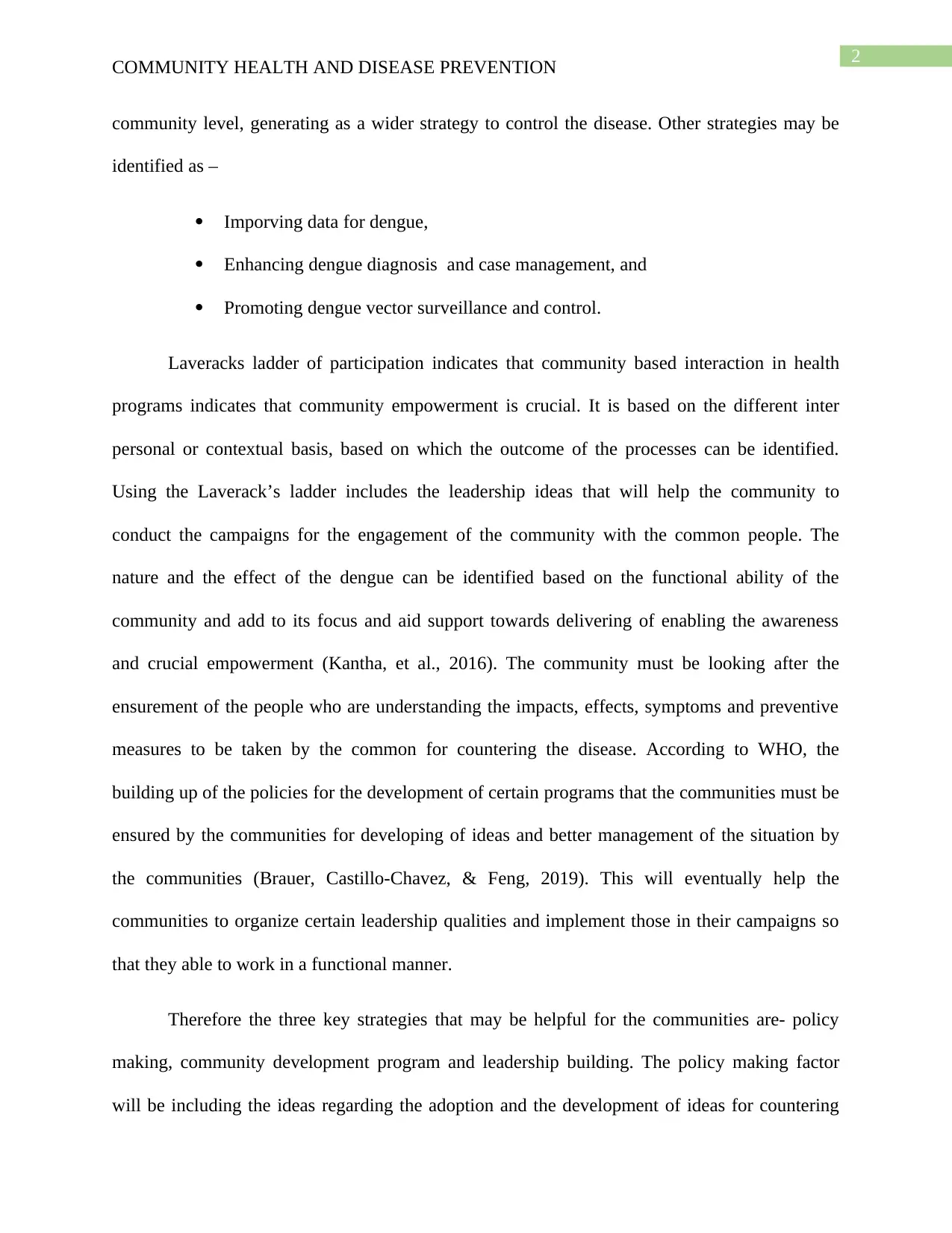
2
COMMUNITY HEALTH AND DISEASE PREVENTION
community level, generating as a wider strategy to control the disease. Other strategies may be
identified as –
Imporving data for dengue,
Enhancing dengue diagnosis and case management, and
Promoting dengue vector surveillance and control.
Laveracks ladder of participation indicates that community based interaction in health
programs indicates that community empowerment is crucial. It is based on the different inter
personal or contextual basis, based on which the outcome of the processes can be identified.
Using the Laverack’s ladder includes the leadership ideas that will help the community to
conduct the campaigns for the engagement of the community with the common people. The
nature and the effect of the dengue can be identified based on the functional ability of the
community and add to its focus and aid support towards delivering of enabling the awareness
and crucial empowerment (Kantha, et al., 2016). The community must be looking after the
ensurement of the people who are understanding the impacts, effects, symptoms and preventive
measures to be taken by the common for countering the disease. According to WHO, the
building up of the policies for the development of certain programs that the communities must be
ensured by the communities for developing of ideas and better management of the situation by
the communities (Brauer, Castillo-Chavez, & Feng, 2019). This will eventually help the
communities to organize certain leadership qualities and implement those in their campaigns so
that they able to work in a functional manner.
Therefore the three key strategies that may be helpful for the communities are- policy
making, community development program and leadership building. The policy making factor
will be including the ideas regarding the adoption and the development of ideas for countering
COMMUNITY HEALTH AND DISEASE PREVENTION
community level, generating as a wider strategy to control the disease. Other strategies may be
identified as –
Imporving data for dengue,
Enhancing dengue diagnosis and case management, and
Promoting dengue vector surveillance and control.
Laveracks ladder of participation indicates that community based interaction in health
programs indicates that community empowerment is crucial. It is based on the different inter
personal or contextual basis, based on which the outcome of the processes can be identified.
Using the Laverack’s ladder includes the leadership ideas that will help the community to
conduct the campaigns for the engagement of the community with the common people. The
nature and the effect of the dengue can be identified based on the functional ability of the
community and add to its focus and aid support towards delivering of enabling the awareness
and crucial empowerment (Kantha, et al., 2016). The community must be looking after the
ensurement of the people who are understanding the impacts, effects, symptoms and preventive
measures to be taken by the common for countering the disease. According to WHO, the
building up of the policies for the development of certain programs that the communities must be
ensured by the communities for developing of ideas and better management of the situation by
the communities (Brauer, Castillo-Chavez, & Feng, 2019). This will eventually help the
communities to organize certain leadership qualities and implement those in their campaigns so
that they able to work in a functional manner.
Therefore the three key strategies that may be helpful for the communities are- policy
making, community development program and leadership building. The policy making factor
will be including the ideas regarding the adoption and the development of ideas for countering
⊘ This is a preview!⊘
Do you want full access?
Subscribe today to unlock all pages.

Trusted by 1+ million students worldwide
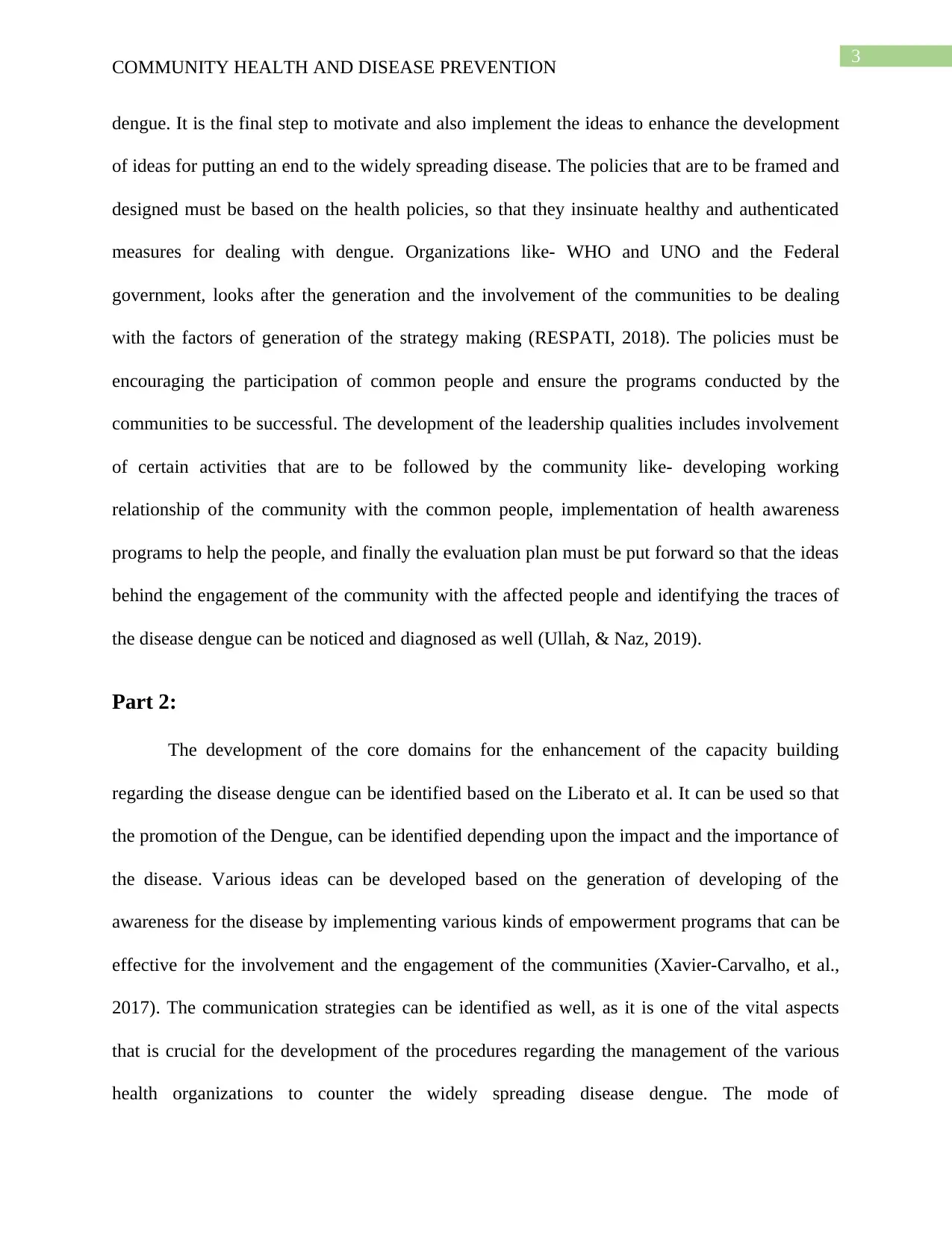
3
COMMUNITY HEALTH AND DISEASE PREVENTION
dengue. It is the final step to motivate and also implement the ideas to enhance the development
of ideas for putting an end to the widely spreading disease. The policies that are to be framed and
designed must be based on the health policies, so that they insinuate healthy and authenticated
measures for dealing with dengue. Organizations like- WHO and UNO and the Federal
government, looks after the generation and the involvement of the communities to be dealing
with the factors of generation of the strategy making (RESPATI, 2018). The policies must be
encouraging the participation of common people and ensure the programs conducted by the
communities to be successful. The development of the leadership qualities includes involvement
of certain activities that are to be followed by the community like- developing working
relationship of the community with the common people, implementation of health awareness
programs to help the people, and finally the evaluation plan must be put forward so that the ideas
behind the engagement of the community with the affected people and identifying the traces of
the disease dengue can be noticed and diagnosed as well (Ullah, & Naz, 2019).
Part 2:
The development of the core domains for the enhancement of the capacity building
regarding the disease dengue can be identified based on the Liberato et al. It can be used so that
the promotion of the Dengue, can be identified depending upon the impact and the importance of
the disease. Various ideas can be developed based on the generation of developing of the
awareness for the disease by implementing various kinds of empowerment programs that can be
effective for the involvement and the engagement of the communities (Xavier-Carvalho, et al.,
2017). The communication strategies can be identified as well, as it is one of the vital aspects
that is crucial for the development of the procedures regarding the management of the various
health organizations to counter the widely spreading disease dengue. The mode of
COMMUNITY HEALTH AND DISEASE PREVENTION
dengue. It is the final step to motivate and also implement the ideas to enhance the development
of ideas for putting an end to the widely spreading disease. The policies that are to be framed and
designed must be based on the health policies, so that they insinuate healthy and authenticated
measures for dealing with dengue. Organizations like- WHO and UNO and the Federal
government, looks after the generation and the involvement of the communities to be dealing
with the factors of generation of the strategy making (RESPATI, 2018). The policies must be
encouraging the participation of common people and ensure the programs conducted by the
communities to be successful. The development of the leadership qualities includes involvement
of certain activities that are to be followed by the community like- developing working
relationship of the community with the common people, implementation of health awareness
programs to help the people, and finally the evaluation plan must be put forward so that the ideas
behind the engagement of the community with the affected people and identifying the traces of
the disease dengue can be noticed and diagnosed as well (Ullah, & Naz, 2019).
Part 2:
The development of the core domains for the enhancement of the capacity building
regarding the disease dengue can be identified based on the Liberato et al. It can be used so that
the promotion of the Dengue, can be identified depending upon the impact and the importance of
the disease. Various ideas can be developed based on the generation of developing of the
awareness for the disease by implementing various kinds of empowerment programs that can be
effective for the involvement and the engagement of the communities (Xavier-Carvalho, et al.,
2017). The communication strategies can be identified as well, as it is one of the vital aspects
that is crucial for the development of the procedures regarding the management of the various
health organizations to counter the widely spreading disease dengue. The mode of
Paraphrase This Document
Need a fresh take? Get an instant paraphrase of this document with our AI Paraphraser
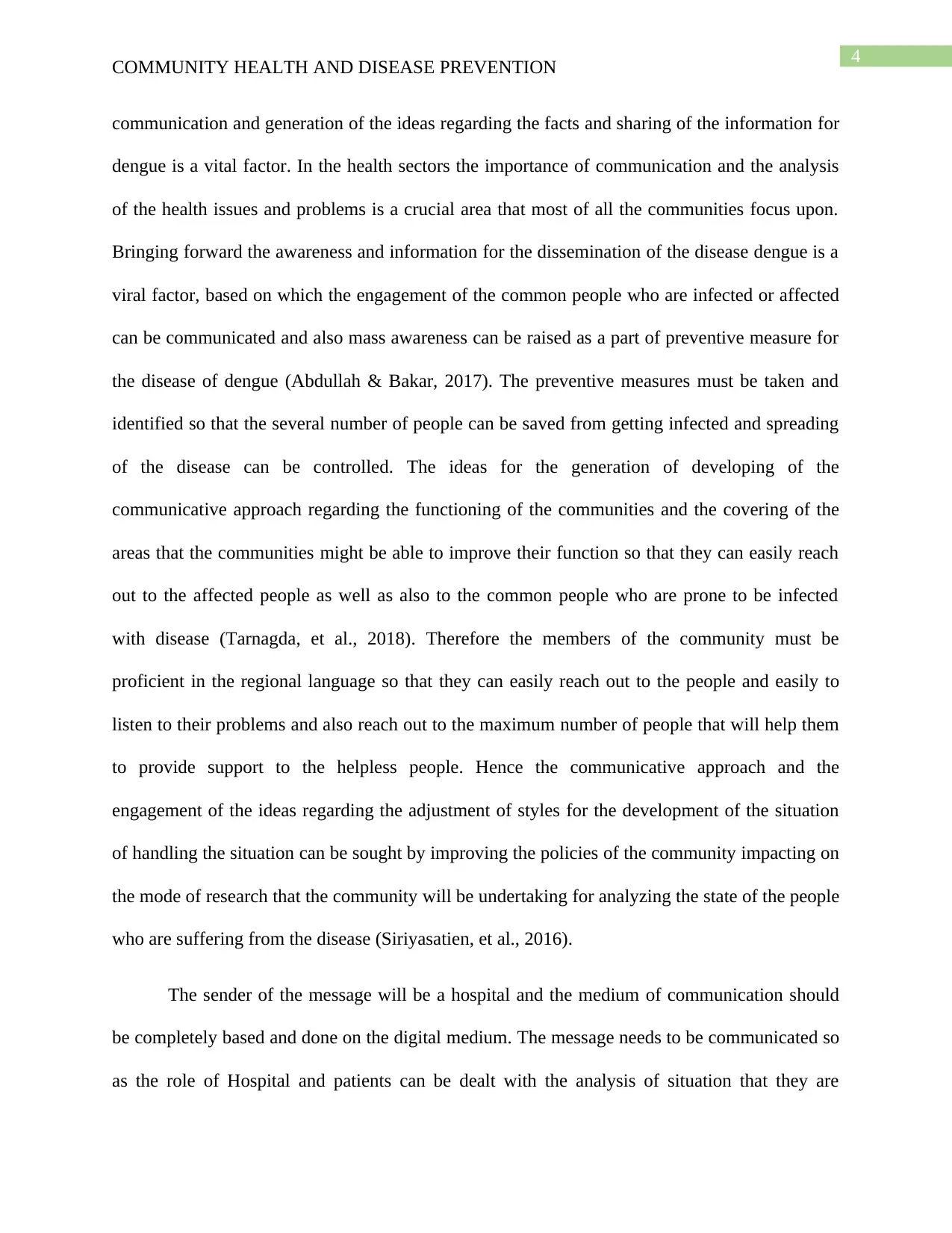
4
COMMUNITY HEALTH AND DISEASE PREVENTION
communication and generation of the ideas regarding the facts and sharing of the information for
dengue is a vital factor. In the health sectors the importance of communication and the analysis
of the health issues and problems is a crucial area that most of all the communities focus upon.
Bringing forward the awareness and information for the dissemination of the disease dengue is a
viral factor, based on which the engagement of the common people who are infected or affected
can be communicated and also mass awareness can be raised as a part of preventive measure for
the disease of dengue (Abdullah & Bakar, 2017). The preventive measures must be taken and
identified so that the several number of people can be saved from getting infected and spreading
of the disease can be controlled. The ideas for the generation of developing of the
communicative approach regarding the functioning of the communities and the covering of the
areas that the communities might be able to improve their function so that they can easily reach
out to the affected people as well as also to the common people who are prone to be infected
with disease (Tarnagda, et al., 2018). Therefore the members of the community must be
proficient in the regional language so that they can easily reach out to the people and easily to
listen to their problems and also reach out to the maximum number of people that will help them
to provide support to the helpless people. Hence the communicative approach and the
engagement of the ideas regarding the adjustment of styles for the development of the situation
of handling the situation can be sought by improving the policies of the community impacting on
the mode of research that the community will be undertaking for analyzing the state of the people
who are suffering from the disease (Siriyasatien, et al., 2016).
The sender of the message will be a hospital and the medium of communication should
be completely based and done on the digital medium. The message needs to be communicated so
as the role of Hospital and patients can be dealt with the analysis of situation that they are
COMMUNITY HEALTH AND DISEASE PREVENTION
communication and generation of the ideas regarding the facts and sharing of the information for
dengue is a vital factor. In the health sectors the importance of communication and the analysis
of the health issues and problems is a crucial area that most of all the communities focus upon.
Bringing forward the awareness and information for the dissemination of the disease dengue is a
viral factor, based on which the engagement of the common people who are infected or affected
can be communicated and also mass awareness can be raised as a part of preventive measure for
the disease of dengue (Abdullah & Bakar, 2017). The preventive measures must be taken and
identified so that the several number of people can be saved from getting infected and spreading
of the disease can be controlled. The ideas for the generation of developing of the
communicative approach regarding the functioning of the communities and the covering of the
areas that the communities might be able to improve their function so that they can easily reach
out to the affected people as well as also to the common people who are prone to be infected
with disease (Tarnagda, et al., 2018). Therefore the members of the community must be
proficient in the regional language so that they can easily reach out to the people and easily to
listen to their problems and also reach out to the maximum number of people that will help them
to provide support to the helpless people. Hence the communicative approach and the
engagement of the ideas regarding the adjustment of styles for the development of the situation
of handling the situation can be sought by improving the policies of the community impacting on
the mode of research that the community will be undertaking for analyzing the state of the people
who are suffering from the disease (Siriyasatien, et al., 2016).
The sender of the message will be a hospital and the medium of communication should
be completely based and done on the digital medium. The message needs to be communicated so
as the role of Hospital and patients can be dealt with the analysis of situation that they are
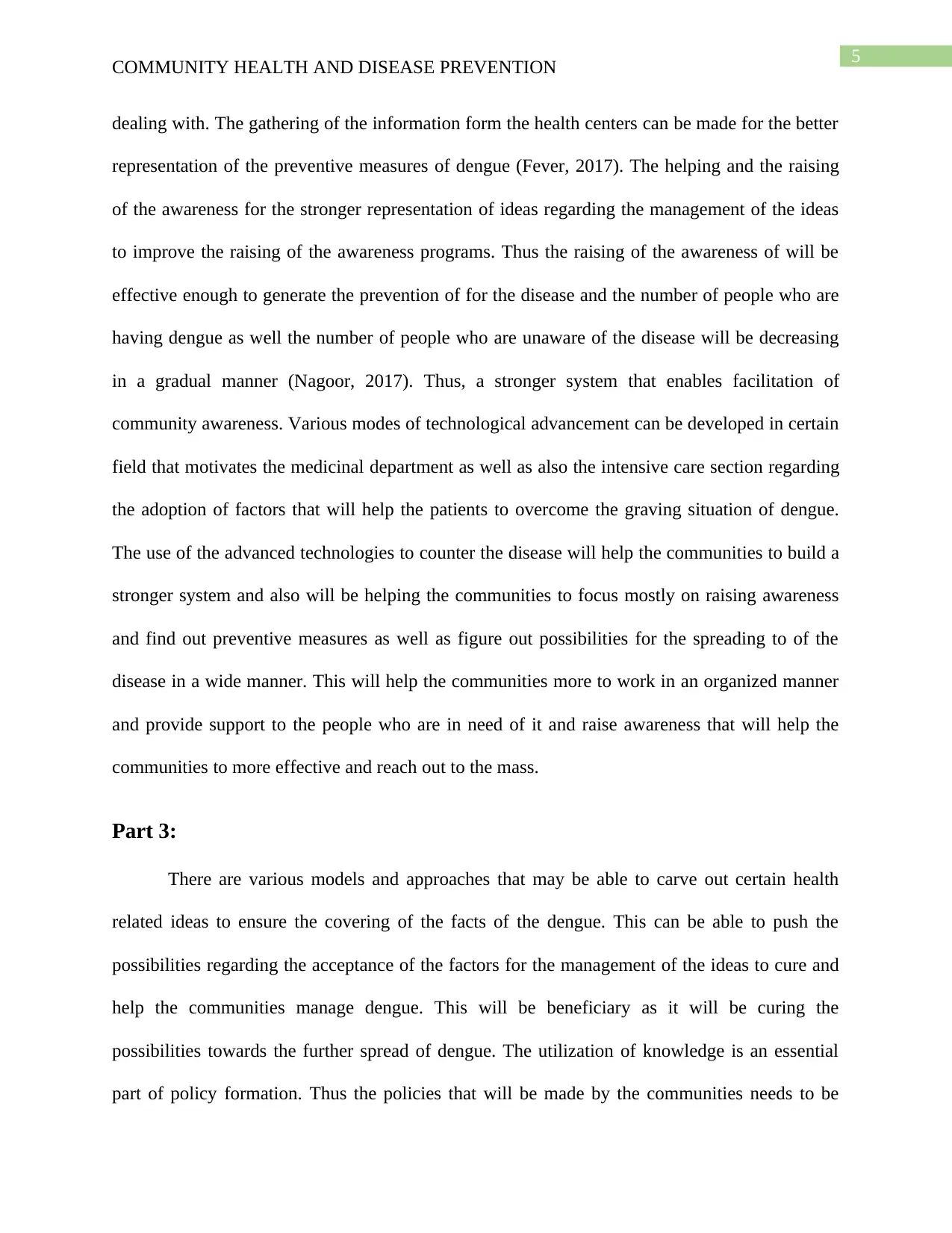
5
COMMUNITY HEALTH AND DISEASE PREVENTION
dealing with. The gathering of the information form the health centers can be made for the better
representation of the preventive measures of dengue (Fever, 2017). The helping and the raising
of the awareness for the stronger representation of ideas regarding the management of the ideas
to improve the raising of the awareness programs. Thus the raising of the awareness of will be
effective enough to generate the prevention of for the disease and the number of people who are
having dengue as well the number of people who are unaware of the disease will be decreasing
in a gradual manner (Nagoor, 2017). Thus, a stronger system that enables facilitation of
community awareness. Various modes of technological advancement can be developed in certain
field that motivates the medicinal department as well as also the intensive care section regarding
the adoption of factors that will help the patients to overcome the graving situation of dengue.
The use of the advanced technologies to counter the disease will help the communities to build a
stronger system and also will be helping the communities to focus mostly on raising awareness
and find out preventive measures as well as figure out possibilities for the spreading to of the
disease in a wide manner. This will help the communities more to work in an organized manner
and provide support to the people who are in need of it and raise awareness that will help the
communities to more effective and reach out to the mass.
Part 3:
There are various models and approaches that may be able to carve out certain health
related ideas to ensure the covering of the facts of the dengue. This can be able to push the
possibilities regarding the acceptance of the factors for the management of the ideas to cure and
help the communities manage dengue. This will be beneficiary as it will be curing the
possibilities towards the further spread of dengue. The utilization of knowledge is an essential
part of policy formation. Thus the policies that will be made by the communities needs to be
COMMUNITY HEALTH AND DISEASE PREVENTION
dealing with. The gathering of the information form the health centers can be made for the better
representation of the preventive measures of dengue (Fever, 2017). The helping and the raising
of the awareness for the stronger representation of ideas regarding the management of the ideas
to improve the raising of the awareness programs. Thus the raising of the awareness of will be
effective enough to generate the prevention of for the disease and the number of people who are
having dengue as well the number of people who are unaware of the disease will be decreasing
in a gradual manner (Nagoor, 2017). Thus, a stronger system that enables facilitation of
community awareness. Various modes of technological advancement can be developed in certain
field that motivates the medicinal department as well as also the intensive care section regarding
the adoption of factors that will help the patients to overcome the graving situation of dengue.
The use of the advanced technologies to counter the disease will help the communities to build a
stronger system and also will be helping the communities to focus mostly on raising awareness
and find out preventive measures as well as figure out possibilities for the spreading to of the
disease in a wide manner. This will help the communities more to work in an organized manner
and provide support to the people who are in need of it and raise awareness that will help the
communities to more effective and reach out to the mass.
Part 3:
There are various models and approaches that may be able to carve out certain health
related ideas to ensure the covering of the facts of the dengue. This can be able to push the
possibilities regarding the acceptance of the factors for the management of the ideas to cure and
help the communities manage dengue. This will be beneficiary as it will be curing the
possibilities towards the further spread of dengue. The utilization of knowledge is an essential
part of policy formation. Thus the policies that will be made by the communities needs to be
⊘ This is a preview!⊘
Do you want full access?
Subscribe today to unlock all pages.

Trusted by 1+ million students worldwide
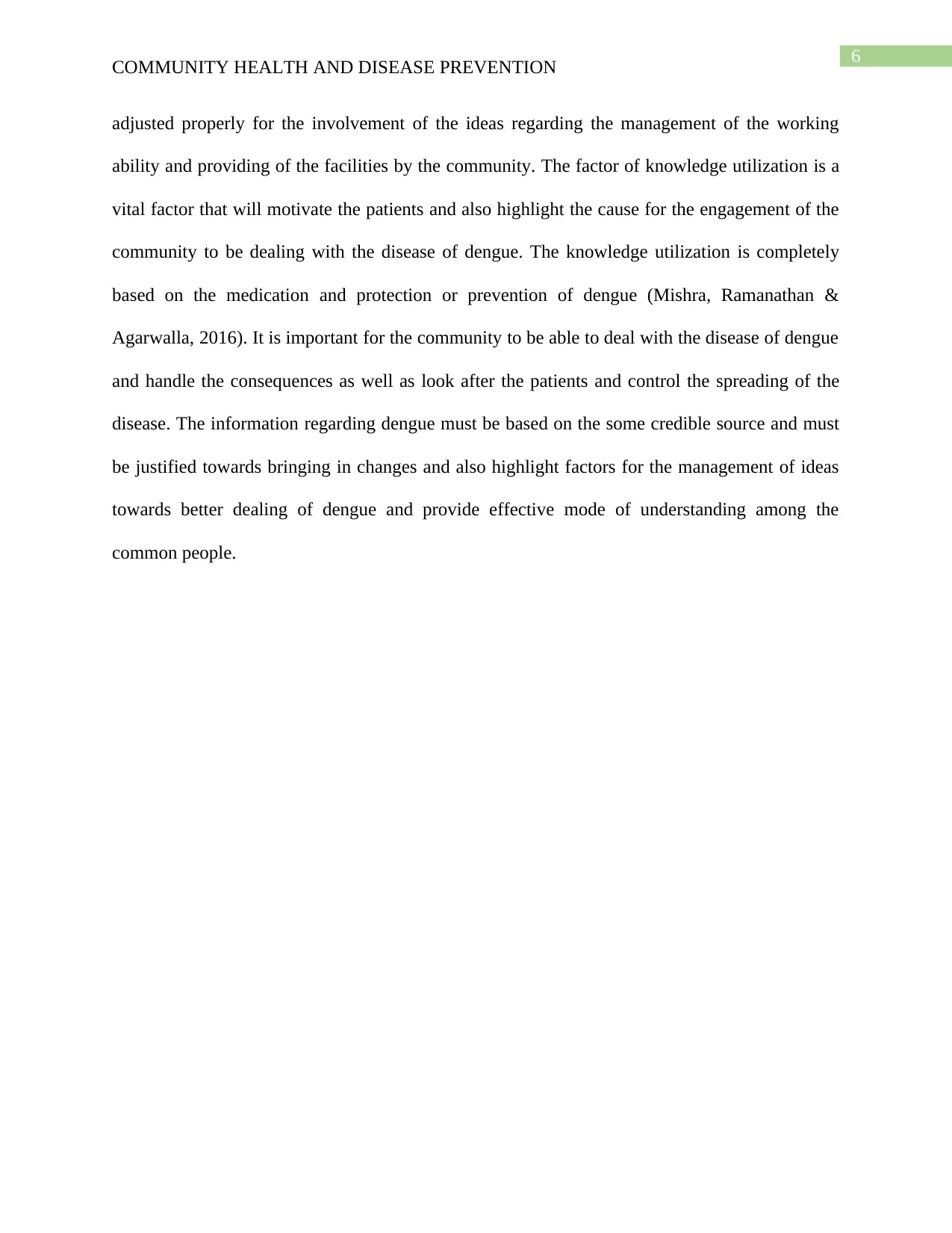
6
COMMUNITY HEALTH AND DISEASE PREVENTION
adjusted properly for the involvement of the ideas regarding the management of the working
ability and providing of the facilities by the community. The factor of knowledge utilization is a
vital factor that will motivate the patients and also highlight the cause for the engagement of the
community to be dealing with the disease of dengue. The knowledge utilization is completely
based on the medication and protection or prevention of dengue (Mishra, Ramanathan &
Agarwalla, 2016). It is important for the community to be able to deal with the disease of dengue
and handle the consequences as well as look after the patients and control the spreading of the
disease. The information regarding dengue must be based on the some credible source and must
be justified towards bringing in changes and also highlight factors for the management of ideas
towards better dealing of dengue and provide effective mode of understanding among the
common people.
COMMUNITY HEALTH AND DISEASE PREVENTION
adjusted properly for the involvement of the ideas regarding the management of the working
ability and providing of the facilities by the community. The factor of knowledge utilization is a
vital factor that will motivate the patients and also highlight the cause for the engagement of the
community to be dealing with the disease of dengue. The knowledge utilization is completely
based on the medication and protection or prevention of dengue (Mishra, Ramanathan &
Agarwalla, 2016). It is important for the community to be able to deal with the disease of dengue
and handle the consequences as well as look after the patients and control the spreading of the
disease. The information regarding dengue must be based on the some credible source and must
be justified towards bringing in changes and also highlight factors for the management of ideas
towards better dealing of dengue and provide effective mode of understanding among the
common people.
Paraphrase This Document
Need a fresh take? Get an instant paraphrase of this document with our AI Paraphraser
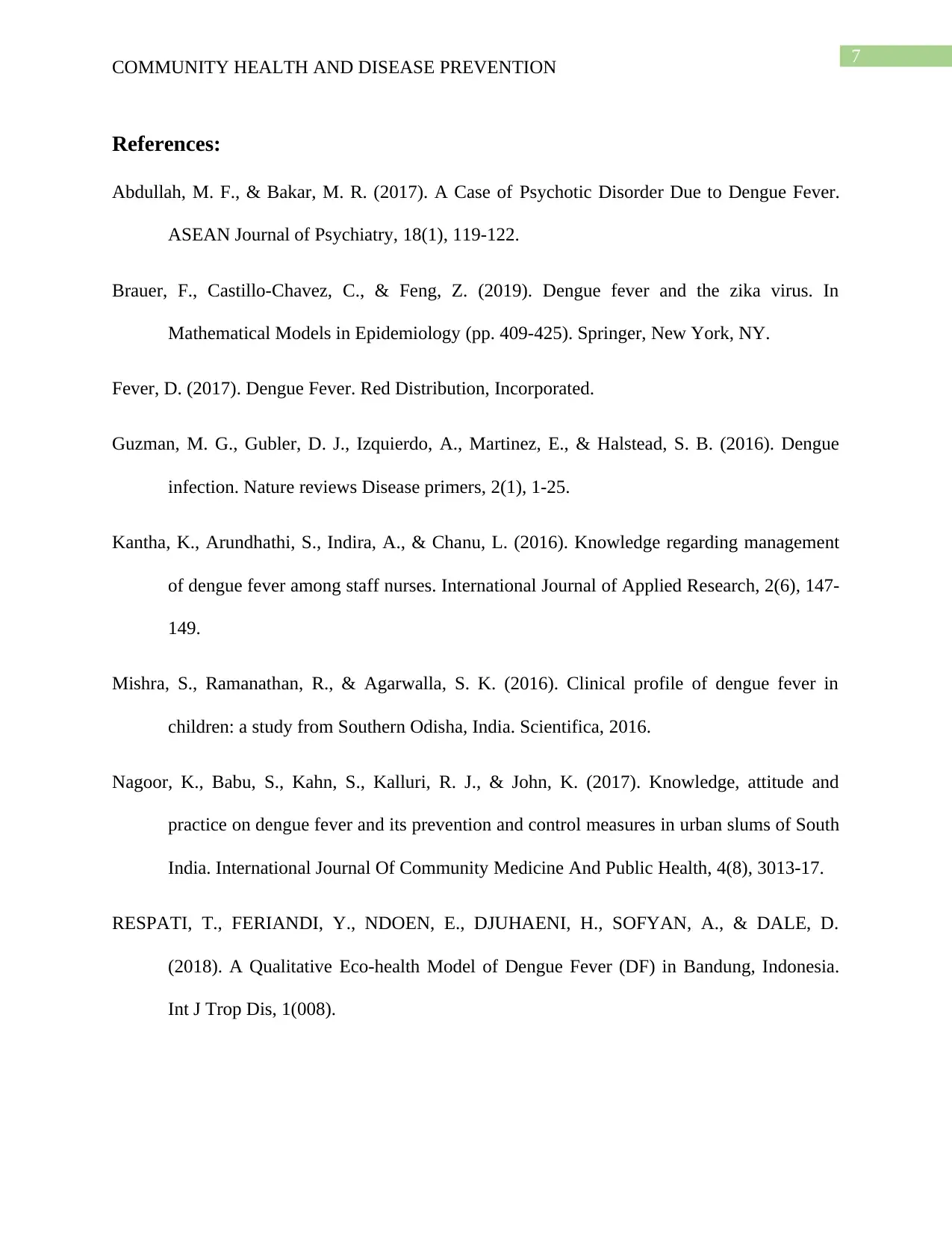
7
COMMUNITY HEALTH AND DISEASE PREVENTION
References:
Abdullah, M. F., & Bakar, M. R. (2017). A Case of Psychotic Disorder Due to Dengue Fever.
ASEAN Journal of Psychiatry, 18(1), 119-122.
Brauer, F., Castillo-Chavez, C., & Feng, Z. (2019). Dengue fever and the zika virus. In
Mathematical Models in Epidemiology (pp. 409-425). Springer, New York, NY.
Fever, D. (2017). Dengue Fever. Red Distribution, Incorporated.
Guzman, M. G., Gubler, D. J., Izquierdo, A., Martinez, E., & Halstead, S. B. (2016). Dengue
infection. Nature reviews Disease primers, 2(1), 1-25.
Kantha, K., Arundhathi, S., Indira, A., & Chanu, L. (2016). Knowledge regarding management
of dengue fever among staff nurses. International Journal of Applied Research, 2(6), 147-
149.
Mishra, S., Ramanathan, R., & Agarwalla, S. K. (2016). Clinical profile of dengue fever in
children: a study from Southern Odisha, India. Scientifica, 2016.
Nagoor, K., Babu, S., Kahn, S., Kalluri, R. J., & John, K. (2017). Knowledge, attitude and
practice on dengue fever and its prevention and control measures in urban slums of South
India. International Journal Of Community Medicine And Public Health, 4(8), 3013-17.
RESPATI, T., FERIANDI, Y., NDOEN, E., DJUHAENI, H., SOFYAN, A., & DALE, D.
(2018). A Qualitative Eco-health Model of Dengue Fever (DF) in Bandung, Indonesia.
Int J Trop Dis, 1(008).
COMMUNITY HEALTH AND DISEASE PREVENTION
References:
Abdullah, M. F., & Bakar, M. R. (2017). A Case of Psychotic Disorder Due to Dengue Fever.
ASEAN Journal of Psychiatry, 18(1), 119-122.
Brauer, F., Castillo-Chavez, C., & Feng, Z. (2019). Dengue fever and the zika virus. In
Mathematical Models in Epidemiology (pp. 409-425). Springer, New York, NY.
Fever, D. (2017). Dengue Fever. Red Distribution, Incorporated.
Guzman, M. G., Gubler, D. J., Izquierdo, A., Martinez, E., & Halstead, S. B. (2016). Dengue
infection. Nature reviews Disease primers, 2(1), 1-25.
Kantha, K., Arundhathi, S., Indira, A., & Chanu, L. (2016). Knowledge regarding management
of dengue fever among staff nurses. International Journal of Applied Research, 2(6), 147-
149.
Mishra, S., Ramanathan, R., & Agarwalla, S. K. (2016). Clinical profile of dengue fever in
children: a study from Southern Odisha, India. Scientifica, 2016.
Nagoor, K., Babu, S., Kahn, S., Kalluri, R. J., & John, K. (2017). Knowledge, attitude and
practice on dengue fever and its prevention and control measures in urban slums of South
India. International Journal Of Community Medicine And Public Health, 4(8), 3013-17.
RESPATI, T., FERIANDI, Y., NDOEN, E., DJUHAENI, H., SOFYAN, A., & DALE, D.
(2018). A Qualitative Eco-health Model of Dengue Fever (DF) in Bandung, Indonesia.
Int J Trop Dis, 1(008).
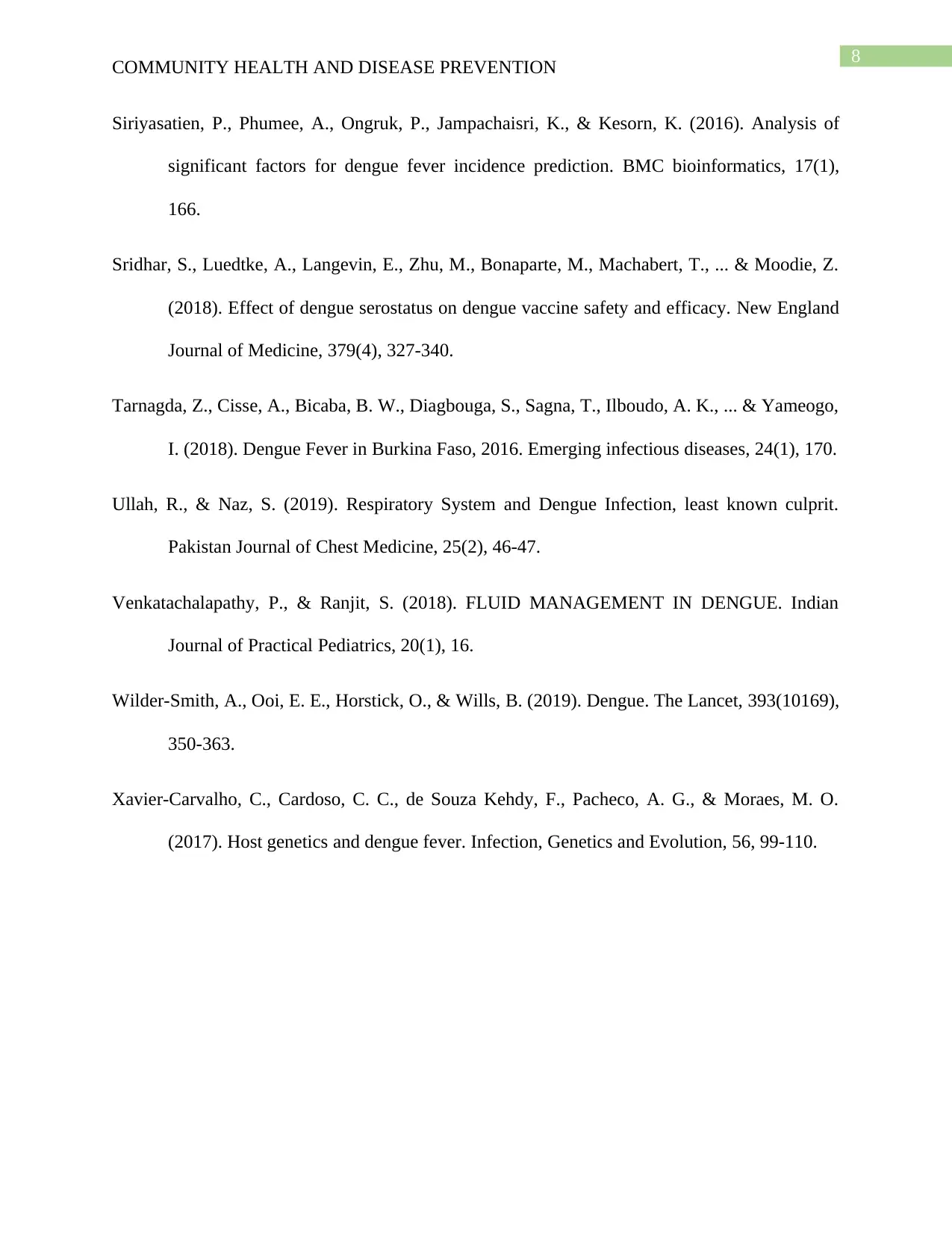
8
COMMUNITY HEALTH AND DISEASE PREVENTION
Siriyasatien, P., Phumee, A., Ongruk, P., Jampachaisri, K., & Kesorn, K. (2016). Analysis of
significant factors for dengue fever incidence prediction. BMC bioinformatics, 17(1),
166.
Sridhar, S., Luedtke, A., Langevin, E., Zhu, M., Bonaparte, M., Machabert, T., ... & Moodie, Z.
(2018). Effect of dengue serostatus on dengue vaccine safety and efficacy. New England
Journal of Medicine, 379(4), 327-340.
Tarnagda, Z., Cisse, A., Bicaba, B. W., Diagbouga, S., Sagna, T., Ilboudo, A. K., ... & Yameogo,
I. (2018). Dengue Fever in Burkina Faso, 2016. Emerging infectious diseases, 24(1), 170.
Ullah, R., & Naz, S. (2019). Respiratory System and Dengue Infection, least known culprit.
Pakistan Journal of Chest Medicine, 25(2), 46-47.
Venkatachalapathy, P., & Ranjit, S. (2018). FLUID MANAGEMENT IN DENGUE. Indian
Journal of Practical Pediatrics, 20(1), 16.
Wilder-Smith, A., Ooi, E. E., Horstick, O., & Wills, B. (2019). Dengue. The Lancet, 393(10169),
350-363.
Xavier-Carvalho, C., Cardoso, C. C., de Souza Kehdy, F., Pacheco, A. G., & Moraes, M. O.
(2017). Host genetics and dengue fever. Infection, Genetics and Evolution, 56, 99-110.
COMMUNITY HEALTH AND DISEASE PREVENTION
Siriyasatien, P., Phumee, A., Ongruk, P., Jampachaisri, K., & Kesorn, K. (2016). Analysis of
significant factors for dengue fever incidence prediction. BMC bioinformatics, 17(1),
166.
Sridhar, S., Luedtke, A., Langevin, E., Zhu, M., Bonaparte, M., Machabert, T., ... & Moodie, Z.
(2018). Effect of dengue serostatus on dengue vaccine safety and efficacy. New England
Journal of Medicine, 379(4), 327-340.
Tarnagda, Z., Cisse, A., Bicaba, B. W., Diagbouga, S., Sagna, T., Ilboudo, A. K., ... & Yameogo,
I. (2018). Dengue Fever in Burkina Faso, 2016. Emerging infectious diseases, 24(1), 170.
Ullah, R., & Naz, S. (2019). Respiratory System and Dengue Infection, least known culprit.
Pakistan Journal of Chest Medicine, 25(2), 46-47.
Venkatachalapathy, P., & Ranjit, S. (2018). FLUID MANAGEMENT IN DENGUE. Indian
Journal of Practical Pediatrics, 20(1), 16.
Wilder-Smith, A., Ooi, E. E., Horstick, O., & Wills, B. (2019). Dengue. The Lancet, 393(10169),
350-363.
Xavier-Carvalho, C., Cardoso, C. C., de Souza Kehdy, F., Pacheco, A. G., & Moraes, M. O.
(2017). Host genetics and dengue fever. Infection, Genetics and Evolution, 56, 99-110.
⊘ This is a preview!⊘
Do you want full access?
Subscribe today to unlock all pages.

Trusted by 1+ million students worldwide
1 out of 9
Related Documents
Your All-in-One AI-Powered Toolkit for Academic Success.
+13062052269
info@desklib.com
Available 24*7 on WhatsApp / Email
![[object Object]](/_next/static/media/star-bottom.7253800d.svg)
Unlock your academic potential
Copyright © 2020–2025 A2Z Services. All Rights Reserved. Developed and managed by ZUCOL.


